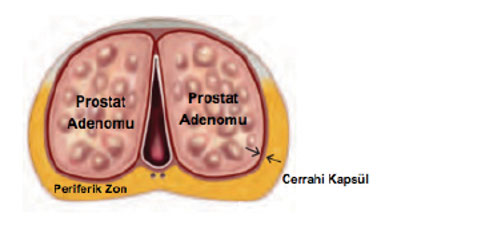Laser Prostate Surgery
What is Laser Prostate Surgery (ThuFLEP / Holep)?
Laser prostate surgery is a closed (endoscopic) surgery performed by entering through the urinary tract in benign prostatic hyperplasia. Basically, LIt is a Prostate Enucleation procedure performed with laser and is named according to the name of the laser used. Today, it is applied to all prostate sizes of 30 grams and above, and it has been shown to be superior to other techniques, especially in patients over 80 grams. It has become the gold standard treatment in these patients.
The widespread use of laser in urology has led to the development of new methods in prostate surgery. Thanks to the good results obtained, the methods that are increasingly popular and used today are Holmium laser prostate enucleation (HoLEP) and Thulium fiber laser prostate enucleation (ThuFLEP). Laser prostate treatment It is a new closed surgical method that allows the removal of all prostate tissue. It is a prostate surgery that is performed closed with a laser and provides similar results to open surgery. These methods are considered the gold standard treatment method of the 21st century in prostate treatment.

How is ThuFLEP / HOLEP surgery performed?
Benign prostatic hyperplasia refers to the growth of prostate tissue surrounding the internal urinary tract (urethra). These growing tissues prostate adenoma It is called. There is a capsule between the prostate adenoma and the outer zone (peripheral zone) of the prostate. This surgical capsule It is called. In surgeries performed for benign prostatic hyperplasia, the prostate adenoma found in this capsule is removed in principle. We call this enucleation. Then, the prostate tissues that are thrown into the bladder (urinary bag) are reduced in size with the help of a morcellator (tissue cutting machine) in a way similar to a mincing machine and removed from the body. The removed prostate parts are sent to the pathology laboratory for pathological examination.

Who is HoLEP / ThuFLEP Recommended for?
Laser prostate surgery is a surgical method that can be applied to anyone who is offered prostate surgery. Since the laser prostate surgery technique has some advantages over other surgical methods, it is applied more safely in cases where other methods cannot be applied.
Although the classic TUR method is not recommended for prostates larger than 80-100 grams, Laser prostate surgery can be applied much more successfully, especially for large prostates. In addition, there is no upper limit for prostate size for Laser Prostate Surgery. In my own practice, I have also performed Laser Prostate Surgery on patients with prostates measuring 250-300 grams.
It is also successfully applied in the same session to patients with bladder stones accompanying prostate enlargement.It is successfully used in patients who previously had a catheter inserted because they were unable to urinate.
It can be applied more safely than other techniques in patients with cardiovascular diseases, those who have coronary stents or have had a bypass in the past, or those who use blood thinners due to vascular occlusion.
ADVANTAGES OVER OTHER TREATMENTS
- Less bleeding.
- Early removal of the catheter.
- Shorter hospitalization period.
- It can be applied to large prostates.
- It allows pathological examination of tissues.
- Returning to daily routine is faster.
- It can be easily applied to those with heart and lung diseases.
- Because the tissue depth is low, the rate of damage to the nerves is low, so erection is less affected.
Will there be bleeding during HoLEP surgery?
In these techniques, as described above, there is no serious bleeding while the tissue is being cut. However, the slightly larger (2-3 mm) arteries that feed the adenoma tissue can be easily stopped with laser energy. Therefore, the amount of bleeding in HoLEP surgery is quite low.
Prostate laser surgery Will there be urinary incontinence after (ThuFLEP / Holep)?
Since surgical technique involves only removing the prostate adenoma, there will be no permanent urinary incontinence after surgery. However, due to other diseases (neurological diseases; Parkinson's, Alzheimer's etc.) and other urological problems (overactive bladder syndrome etc.), you may experience urinary incontinence after surgery. You must be informed by your doctor before surgery.
Prostate laser surgery (ThuFLEP / Holep) will there be an erection problem afterwards?
Since the nerves that provide erection run outside the prostate, the sexual functions of the patients are not affected after these surgeries.
Prostate laser surgery (ThuFLEP / Holep) How many days does the urinary catheter stay in?
This decision may vary depending on factors such as the patient's other illnesses, use of blood thinners, and the severity of the prostate (in very large prostates such as 300-400 grams, it may remain for another day). However, in our practice, we usually remove the catheter 2 days after surgery. We then send the patient home after seeing that he has urinated several times without bleeding on the second day after surgery.
